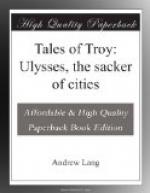The women wore the smock, with more brooches and jewels than the men; and had head coverings, with veils, and mantles over all, and necklaces of gold and amber, earrings, and bracelets of gold or of bronze. The colours of their dresses were various, chiefly white and purple; and, when in mourning, they wore very dark blue, not black. All the armour, and the sword blades and spearheads were made, not of steel or iron, but of bronze, a mixture of copper and tin. The shields were made of several thicknesses of leather, with a plating of bronze above; tools, such as axes and ploughshares, were either of iron or bronze; and so were the blades of knives and daggers.
To us the houses and way of living would have seemed very splendid, and also, in some ways, rather rough. The palace floors, at least in the house of Ulysses, were littered with bones and feet of the oxen slain for food, but this happened when Ulysses had been long from home. The floor of the hall in the house of Ulysses was not boarded with planks, or paved with stone: it was made of clay; for he was a poor king of small islands. The cooking was coarse: a pig or sheep was killed, roasted and eaten immediately. We never hear of boiling meat, and though people probably ate fish, we do not hear of their doing so, except when no meat could be procured. Still some people must have liked them; for in the pictures that were painted or cut in precious stones in these times we see the half-naked fisherman walking home, carrying large fish.
The people were wonderful workers of gold and bronze. Hundreds of their golden jewels have been found in their graves, but probably these were made and buried two or three centuries before the time of Ulysses. The dagger blades had pictures of fights with lions, and of flowers, inlaid on them, in gold of various colours, and in silver; nothing so beautiful is made now. There are figures of men hunting bulls on some of the gold cups, and these are wonderfully life-like. The vases and pots of earthenware were painted in charming patterns: in short, it was a splendid world to live in.
The people believed in many Gods, male and female, under the chief God, Zeus. The Gods were thought to be taller than men, and immortal, and to live in much the same way as men did, eating, drinking, and sleeping in glorious palaces. Though they were supposed to reward good men, and to punish people who broke their oaths and were unkind to strangers, there were many stories told in which the Gods were




